


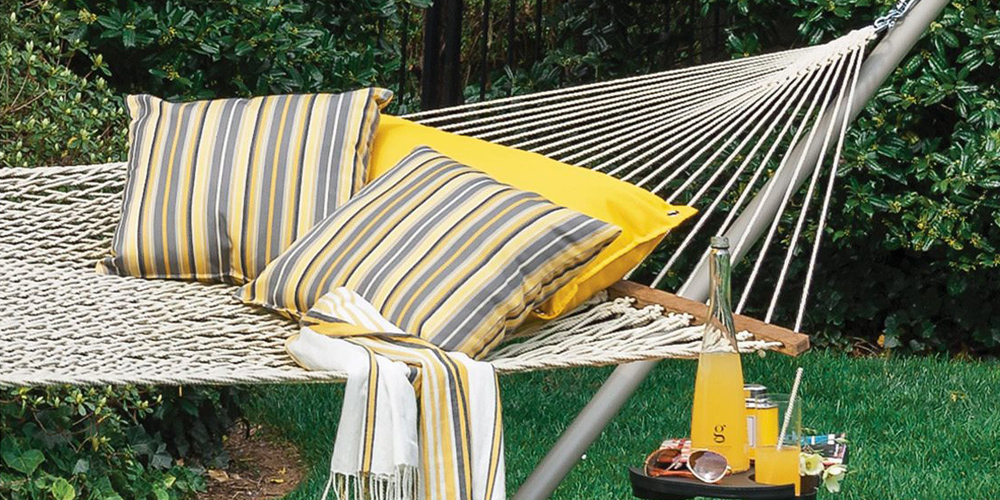
Hammocks offer optimum outdoor comfort, creating a place to kick back and relax while suspended above ground. Choosing the best hammock suited for your needs and location will help achieve blissful tranquility in any outdoor setting. From determining the ideal type of hammock suited to your needs, to proper hanging, and care, this guide will make selecting a hammock for your home a breeze.
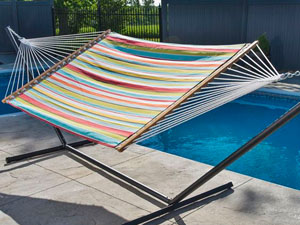
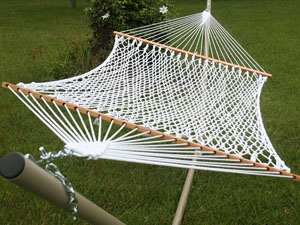
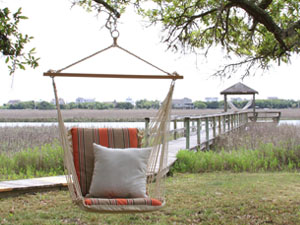
Hammock chairs (and hammock swings) are ideal for customers who want to sit instead of lie down. They are also ideal in small spaces as an alternative to full-sized hammocks. Hammock chairs are more stable and less prone to flipping because they require only one support joint. Hammock chairs are available in the same materials as standard hammocks.
Hammock setup often requires a sturdy suspension system and a pair of carabiners to properly and safely support a hammock. Look for hammocks equipped with many attachment points which will allow for more setup adjustability and more flexibility in the types of post supports you use. Suspension options include nylon ropes (watch out for overly stretchy ropes that will slowly loosen over time) and webbing straps (they should measure wider than .75 inches to prevent wear on the post).
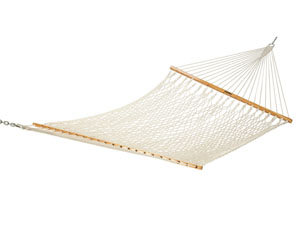
Spreader bars are located at the head and foot of a hammock bed, stretching out the hammock laterally which prevents the hammock bed from folding into a cocoon. Hammocks with spreader bars require more accuracy in hanging. A general rule of thumb to follow requires hammocks with spreader bars hang from post supports at least as far apart as the hammock is long. To achieve maximum comfort, extend the hammock the same length in both directions. Never extend a hammock more than 3 feet total.
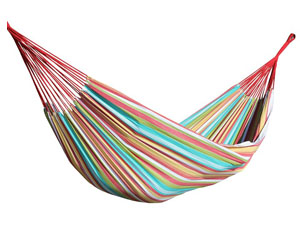
Hammocks without spreader bars create a cocoon-like shape because the material is not stretched out to create a flat bad. Hammocks without spreader bars offer greater flexibility in hanging options. As a general rule, hammocks without spreader bars can be hung from a distance less than the overall length of the hammock, but no smaller than two-thirds of the hammock length. The closer the distance between post supports, the higher off the ground you will need to hang the hammock to prevent the natural dip that occurs with these types of hammocks to hit the ground. Hammocks without spreader bars are not ideal for children to use, as often they find it difficult to get in and out of these types of hammocks.
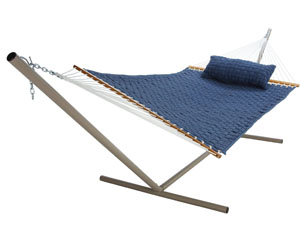
If there is not a proper location to hang a hammock (lacking any support posts), a hammock stands allows you to erect a hammock anywhere, in any location. Consider the size and material of a hammock stand to safely hang a hammock.
Hammock support setups can weigh as little as 7 ounces to a few pounds. Hammocks have weight limits that support weights ranging from 150 to 500 pounds. The weight that a hammock supports refers to static weight.
Hammock widths vary as small as 4 feet, to as large as 9 feet. Hammocks that measure between 6-7 feet will comfortably accommodate a single user or a couple, depending on how much extra room you like to stretch out.
Hammock lengths vary considerably less, and largely depends on personal preference. For taller customers, look for hammocks that measure longer than 8 feet.
The height at which a hammock should hang will depend on a number of factors including whether it is equipped with spreader bars, the type of suspension system utilized, and personal preference. The hanging space should be between 18-24 inches greater than the hammock’s total length, from ring to ring. Keep in mind that the closer the post supports, the more curved the hammock will hang. The following chart shows the ideal height and distance for hanging a hammock.
|
Hammock Length |
Distance Between Trees or Posts |
|||||
|
|
Height of Tree Hooks (in Feet) |
|||||
|
|
10’ |
11’ |
12’ |
13’ |
14’ |
15’ |
|
9’ |
4 feet |
4 feet |
4 feet |
4 feet |
4 feet |
4 feet |
|
10’ |
4.5 feet |
4 feet |
4 feet |
4 feet |
4 feet |
4 feet |
|
11’ |
5.5 feet |
4.5 feet |
4 feet |
4 feet |
4 feet |
4 feet |
|
12’ |
|
6 feet |
5 feet |
4 feet |
4 feet |
4 feet |
|
13’ |
|
|
6 feet |
5 feet |
4 feet |
4 feet |
|
14’ |
|
|
|
6 feet |
5 feet |
4 feet |



